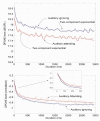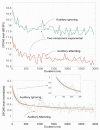Cognitive task demands modulate the sensitivity of the human cochlea
- PMID: 22347870
- PMCID: PMC3277933
- DOI: 10.3389/fpsyg.2012.00030
Cognitive task demands modulate the sensitivity of the human cochlea
Abstract
Recent studies lead to the conclusion that focused attention, through the activity of corticofugal and medial olivocochlear (MOC) efferent pathways, modulates activity at the most peripheral aspects of the auditory system within the cochlea. In two experiments, we investigated the effects of different intermodal attention manipulations on the response of outer hair cells (OHCs), and the control exerted by the MOC efferent system. The effect of the MOCs on OHC activity was characterized by measuring the amplitude and rapid adaptation time course of distortion product otoacoustic emissions (DPOAEs). In the first, DPOAE recordings were compared while participants were reading a book and counting the occurrence of the letter "a" (auditory-ignoring) and while counting either short- or long-duration eliciting tones (auditory-attending). In the second, DPOAEs were recorded while subjects watched muted movies with subtitles (auditory-ignoring/visual distraction) and were compared with DPOAEs recorded while subjects counted the same tones (auditory-attending) as in Experiment 1. In both Experiments 1 and 2, the absolute level of the averaged DPOAEs recorded during the auditory-ignoring condition was statistically higher than that recorded in the auditory-attending condition. Efferent-induced rapid adaptation was evident in all DPOAE contours, under all attention conditions, suggesting that two medial efferent processes act independently to determine rapid adaptation, which is unaffected by attention, and the overall DPOAE level, which is significantly affected by changes in the focus of attention.
Keywords: DPOAE; MOC; corticofugal pathways; distortion product otoacoustic emission; human; medial olivocochlear efferents; selective auditory attention.
Figures




Similar articles
-
Effects of cross-modal selective attention on the sensory periphery: cochlear sensitivity is altered by selective attention.Neuroscience. 2012 Oct 25;223:325-32. doi: 10.1016/j.neuroscience.2012.07.062. Epub 2012 Aug 4. Neuroscience. 2012. PMID: 22871520 Free PMC article.
-
Interaural attention modulates outer hair cell function.Eur J Neurosci. 2014 Dec;40(12):3785-92. doi: 10.1111/ejn.12746. Epub 2014 Oct 10. Eur J Neurosci. 2014. PMID: 25302959 Free PMC article.
-
Measurement of medial olivocochlear efferent activity in humans: comparison of different distortion product otoacoustic emission-based paradigms.Otol Neurotol. 2011 Oct;32(8):1379-88. doi: 10.1097/MAO.0b013e31822f1548. Otol Neurotol. 2011. PMID: 21921859
-
Morphofunctional alterations in the olivocochlear efferent system of the genetic audiogenic seizure-prone hamster GASH:Sal.Epilepsy Behav. 2017 Jun;71(Pt B):193-206. doi: 10.1016/j.yebeh.2016.05.040. Epub 2016 Aug 1. Epilepsy Behav. 2017. PMID: 27492627 Review.
-
Olivocochlear efferents: Their action, effects, measurement and uses, and the impact of the new conception of cochlear mechanical responses.Hear Res. 2018 May;362:38-47. doi: 10.1016/j.heares.2017.12.012. Epub 2017 Dec 21. Hear Res. 2018. PMID: 29291948 Free PMC article. Review.
Cited by
-
Relationships between the expectations based on the regularity of preceding sound sequences and the medial olivocochlear reflex.PLoS One. 2024 Jul 17;19(7):e0304027. doi: 10.1371/journal.pone.0304027. eCollection 2024. PLoS One. 2024. PMID: 39018315 Free PMC article.
-
Expectations of the timing and intensity of a stimulus propagate to the auditory periphery through the medial olivocochlear reflex.Cereb Cortex. 2022 Nov 9;32(22):5121-5131. doi: 10.1093/cercor/bhac002. Cereb Cortex. 2022. PMID: 35094068 Free PMC article.
-
Attentional modulation of the inner ear: a combined otoacoustic emission and EEG study.J Neurosci. 2014 Jul 23;34(30):9995-10002. doi: 10.1523/JNEUROSCI.4861-13.2014. J Neurosci. 2014. PMID: 25057201 Free PMC article. Clinical Trial.
-
Changing What You See by Changing What You Know: The Role of Attention.Front Psychol. 2017 May 1;8:553. doi: 10.3389/fpsyg.2017.00553. eCollection 2017. Front Psychol. 2017. PMID: 28507524 Free PMC article.
-
Difference in Perseverative Errors during a Visual Attention Task with Auditory Distractors in Alpha-9 Nicotinic Receptor Subunit Wild Type and Knock-Out Mice.Front Cell Neurosci. 2017 Nov 8;11:357. doi: 10.3389/fncel.2017.00357. eCollection 2017. Front Cell Neurosci. 2017. PMID: 29163062 Free PMC article.
References
Grants and funding
LinkOut - more resources
Full Text Sources

